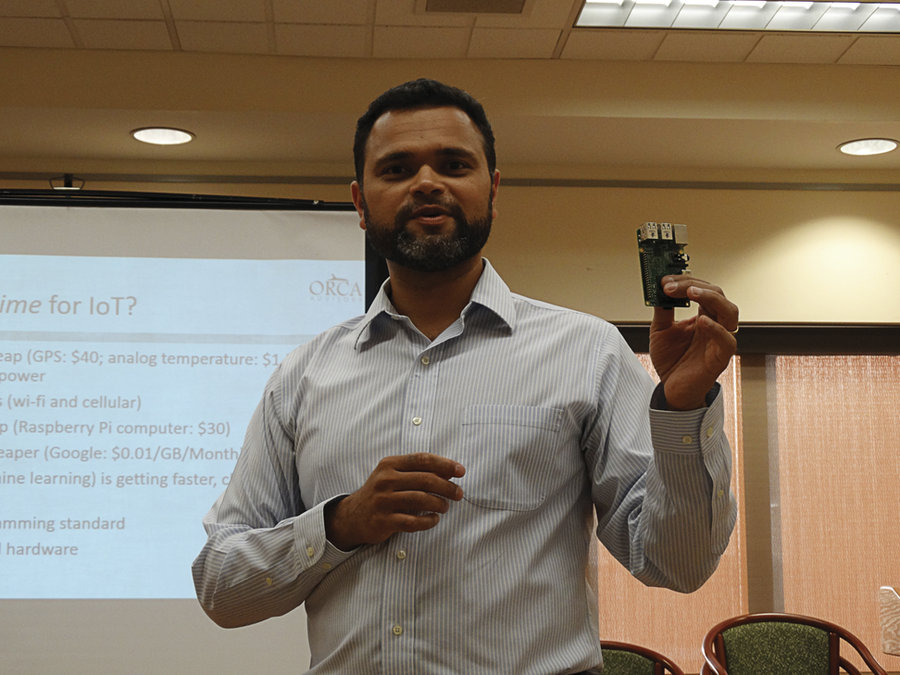All of us are surrounded by a new Internet, one that is growing every day. It is the Internet of Things, an interactive network between devices and physical objects able to exchange data with other devices and objects – maybe one day without the need for human interaction.
“We’re combining electronics with the Internet, and that’s a very powerful combination,” explained Siddharth “Sidd” Saran, CFO of Product Lab, a technology company incubator and the founder of Invntr, a local business providing STEM educational workshops for children.
Saran recently co-hosted an informational session at the Secaucus Public Library and Business Resource Center to explain the impact and application of the Internet of Things alongside his colleague Robert Crimmins, who provided demonstrations.
“You have devices with sensors, which can sense things like temperature, humidity, pressure, etc.,” said Saran. “And you have actuators, or things that do stuff, whether it’s a motor running, or a bulb going on or off, or sending a message, a telephone call, or an email. These interact with the Internet to help solve problems or generate processes.”
As a simple example he cited sensors that automatically turn sprinklers on and off in a garden. That technology is as established as the thermostat in your home, but newer wrinkles allow for more specific tweaking, such as monitoring the soil moisture level and watering according to need, or customizing the system to provide different levels of watering to specific plants.
“The real power of the Internet of Things is when the sensor is combined with things that are happening on the Internet,” said Saran. In this example that might mean notifying you on your cell phone when the moisture level drops or the sprinkler turns on.
Or helping to park your car. Anyone who has visited a crowded mall has experienced the frustration of trying to find a parking space. New technology is spreading that will monitor which spaces are empty in parking lots and display that information to make it easier to locate a spot.
Who could argue with that?
The Internet is watching you
“Technologies in the home are going to be big,” said Saran. “For example let’s say you’re running out of milk. What’s going to happen is you get a message on your phone saying ‘Milk is low.’ Or better yet, it will just automatically fill up your shopping list: ‘Buy milk.’ So you go shopping and you look at your Google app and you’ve got five things. Milk is low, you need eggs, etc.”
The technology is already spreading rapidly in the healthcare industry. “Wearables like your smart watch and your FitBit are just one small application,” said Saran, citing new strides in wearable monitors to detect things like the early warning signs of heart attacks.
“Computers can analyze this data and get better and better decision-making by themselves over time without human interaction.” – Sidd Saran
____________
The unit can also be programmed to send the results to your doctor and notify a nearby pharmacy to place an order for medicine. “Now you’ve gone and picked up the medicine and taken it home without your son, who has the flu, going out of the house and potentially infecting others.”
“The excitement about the Internet of Things is that it’s generating data, and all this data can now be analyzed to recognize patterns which help make decisions,” he continued. “That’s called ‘machine learning.’ With increasing amounts of data being generated, computers can analyze this data and get better and better decision-making by themselves over time without human interaction.”
That may sound like a scenario from a “Terminator” movie, and some people are concerned about surrendering personal data into the Web.
“Google is a self-learning technology that people use for free but really Google is recognizing data about you and then selling it to somebody else,” said Saran. “Not everybody likes that but people still use it. The concerns of this technology are privacy and security. Companies are actively working on solving those problems. Not everybody is going to like a self-learning technology. But I think what people will come to recognize is that the benefit of using it may outweigh the annoyance of some machine monitoring you.”
Tech and business
The reasons for the recent growth of the Internet of Things are simple. “Sensors are becoming more varied, faster, better, cheaper,” said Saran. “A temperature sensor, which is very useful, costs about $1.50. Connectivity is ubiquitous, so you pretty much have WiFi or a network everywhere. Computer power has become cheaper.”
Small processors that basically serve as scaled-down computers cost as little as $30 each, making it cost-effective to purchase as many as you need and dedicating them to a single purpose.
That makes the Internet of Things attractive to business large or small, to help control costs or increase revenue. Devices can be tailored to automatically monitor machinery for potential problems, or analyze sales and stock levels in order to adjust manufacturing processes.
Recently Saran founded the company Orca Advisory (“I just love the fish,” he explained) to help small and medium-sized businesses connect to technology solutions using the Internet of Things. Having previously hosted a session on technology for kids at the library, he was familiar to Library Director Jenifer May.
“He came to the office a few weeks ago and he had just gotten back from a conference on the Internet of Things, and I had just gotten back from a conference where we talked a lot about the same topic,” said May. “I found it really interesting, so it sounded like a great idea to provide a session here. We already offer basic computer courses, and I’m hoping to do some throughout the year that are a little bit more about hard tech and business and the connection between them.”
For more information on upcoming sessions at the library, visit secaucuslibrary.org.
Art Schwartz may be reached at arts@hudsonreporter.com.
